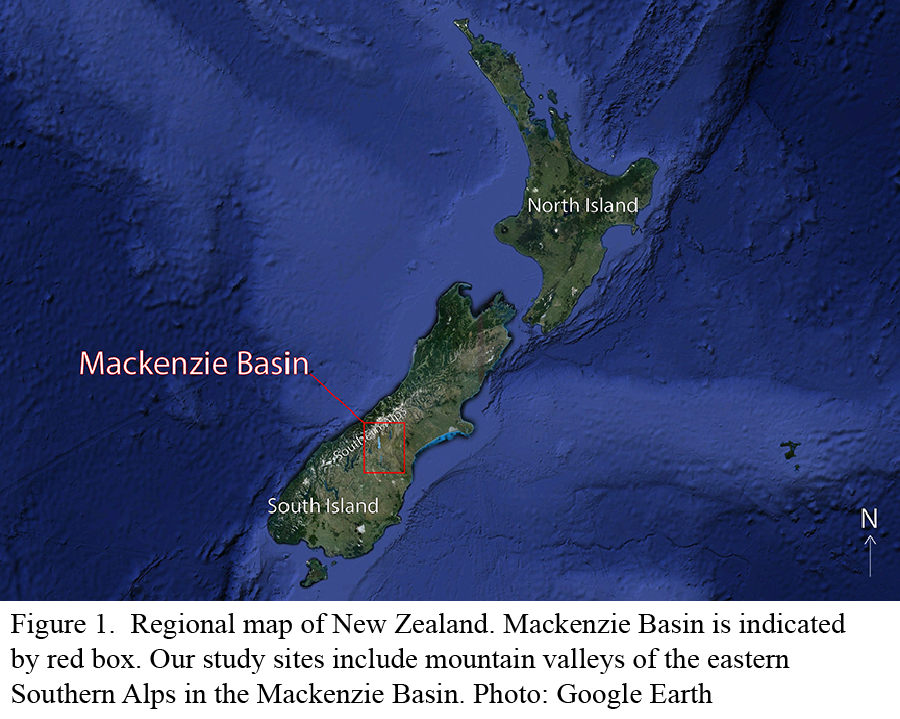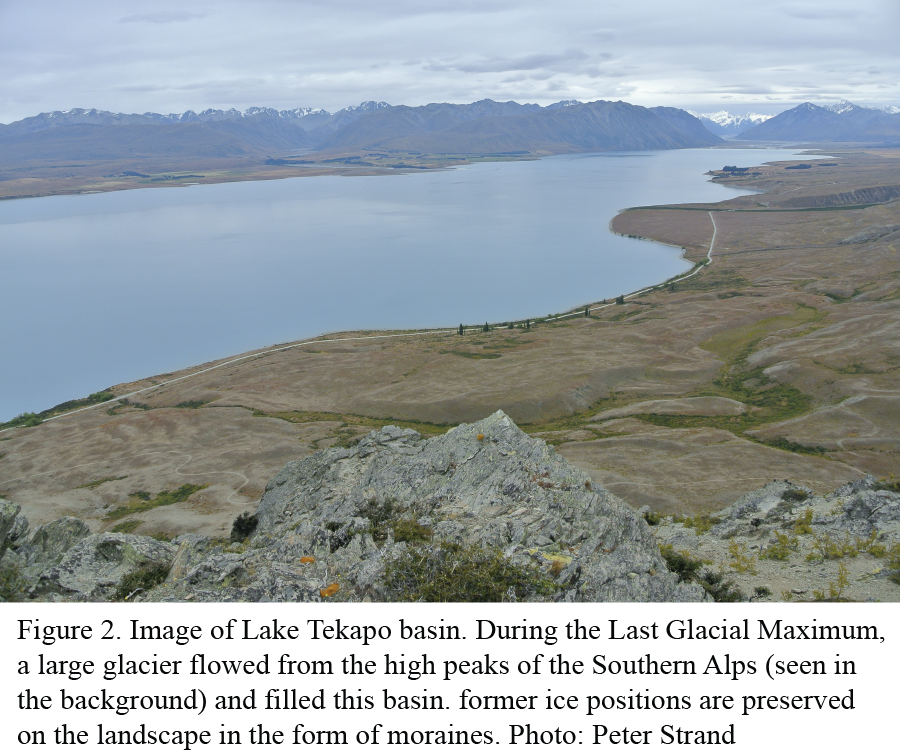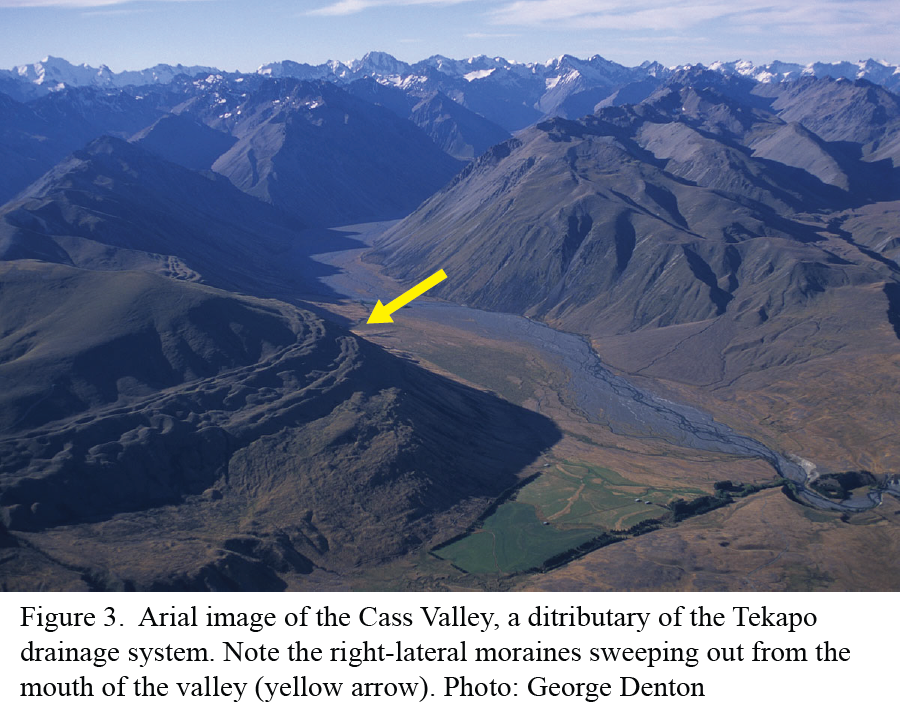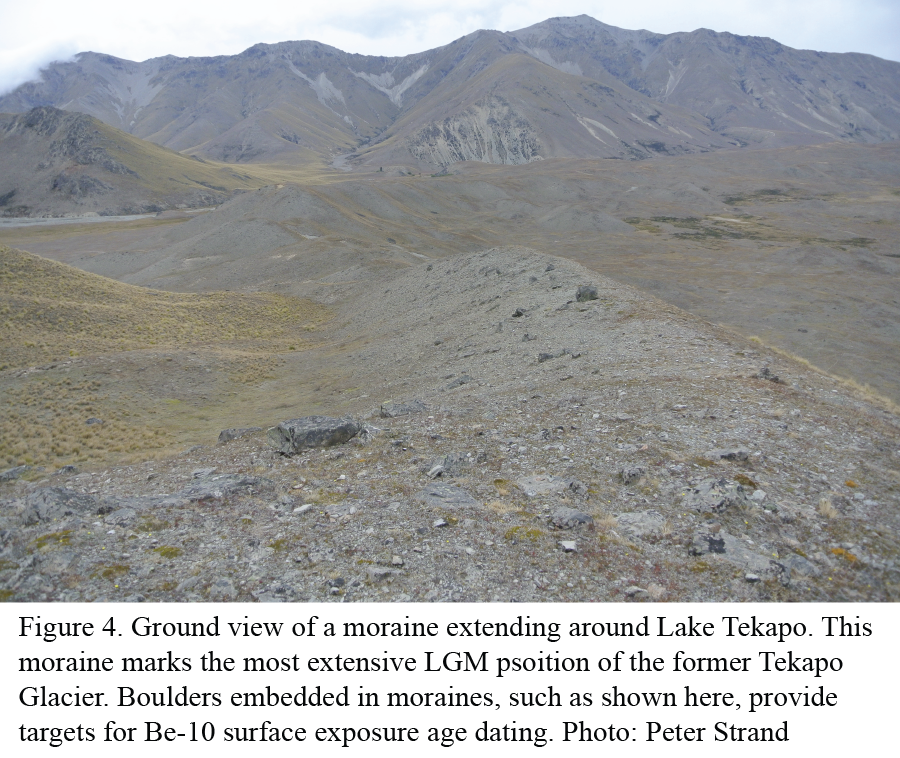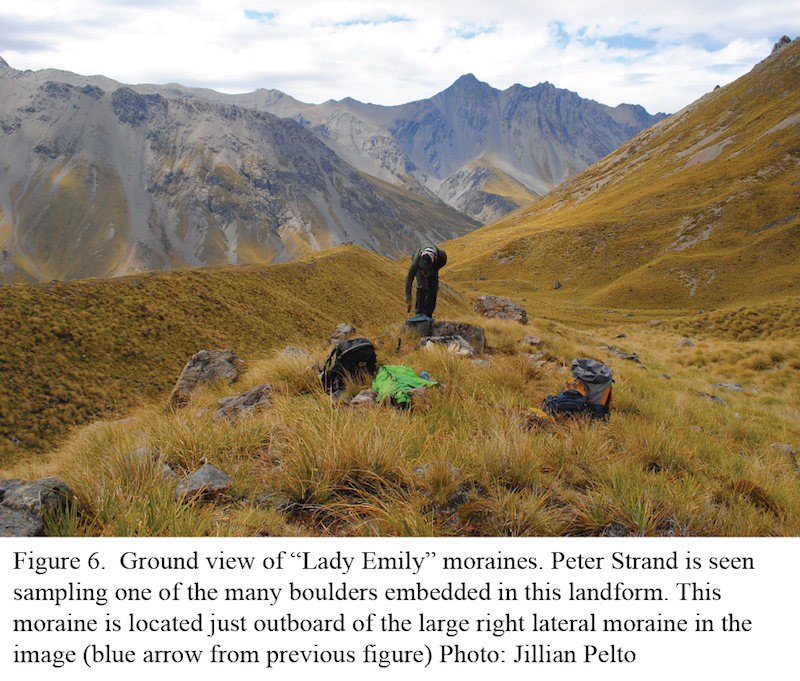
Constructing a 10Be surface-exposure chronology of glacier recession during the last glacial termination in the Southern Alps of New Zealand
Field Team Members: Peter D. Strand (PhD candidate), George H. Denton, Aaron E. Putnam, Jillian Pelto (M.S. candidate)
Collaborators: Dr. Joerg M. Schaefer (Columbia University), David J.A. Barrell (GNS Science), Dr. Brian M. Anderson (Victoria University of Wellington), Dr. Andrew Mackintosh (Victoria University of Wellington), Dr. Joellen Russel (University of Arizona)
New Zealand Southern Alps. January 15, 2017 – March 1, 2017
Funding support: Dan & Betty Churchill Exploration Fund & Comer Family Foundation
Expedition Summary:
Research Background and Motivation
Late Pleistocene ice ages represent the largest changes in Earth’s climate over the past one million years. Uncovering the causes of ice age inceptions and their terminations remains a major mystery in paleoclimate. In addition, understanding the reorganizations of Earth’s atmospheric and oceanic circulations is the key to understanding how Earth’s climate system operates. We are interested in climate fluctuations during the Last Glacial Maximum (~26,000 – 16,000 yrs ago) and last glacial termination (~18,000 – 11,000 yrs ago). We travelled to New Zealand to determine both the chronology and the signature of rapid transitions from glacial to interglacial conditions, known as glacial terminations. Was the timing of glacial terminations in the Northern and Southern Hemispheres the same, or did it differ? In addition, the last glacial termination represents one of most rapid global warming events in Earth’s recent history (Clark et al., 2012; Denton et al., 2010). This glacial-to-interglacial transition also represents the last time atmospheric CO2 rose by a substantial amount prior to the industrial period. However, the relative role of CO2 in driving glacial cycles is not yet known. This problem bears directly on our understanding of global climate dynamics and the sensitivity of the climate system to CO2 forcing. Was the initiation of the last glacial maximum coeval with the rise in atmospheric CO2 registered in the WAIS Divide ice core (Marcott et al., 2014), or did it occur before or after the registered rise in CO2? Were variations in atmospheric CO2 the major driver of the global last glacial termination or were rising atmospheric CO2 levels a legacy of other global changes? In addition, this research affords a test of different explanations for the processes that simultaneously ended the last ice age in both hemispheres, despite opposing overhead summer insolation signals (Milankovitch, 1941). In order to decipher these important paleoclimate problems, we travelled to mountain glaciers in the Mackenzie Basin of the South Island of New Zealand in order to document the reduction of glacier volume since the peak of the last ice age to today’s conditions.
Field Area:
New Zealand is an ideal location for developing a southern hemisphere glacial chronology. New Zealand is antipodal to the North Atlantic region, and thus on the opposite side of the planet from extensive Northern Hemisphere glaciers in both North America and Europe. The South Island extends from 40-46°S, 164-170°E, placing it on the fringe of the Southern Ocean, just north of the modern subtropical front, and squarely in the Southern Hemisphere westerly wind belt. The modern mean-annual snowline currently intersects the Southern Alps, the mountain range extending down the spine of the South Island. The Mackenzie Basin is located at ~44°S latitude, in the eastern rain shadow of the Southern Alps. The complete glacial record of both the Holocene and Late Pleistocene is well preserved on the landscape.
Expedition Report:
During our most recent field season, we focused our sampling efforts on glacial deposits from glaciers draining the high elevation ice-fields around Aoraki/Mt. Cook into the Tekapo Lake Basin. During the Last Glacial Maximum, these glaciers coalesced to form large piedmont lobes that shaped a variety of glacial landforms seen today. Debris deposited at the margins of the glacier formed large ridges on the landscape, known as moraines. The moraine ridges represent the spatial extent of the glacier, when atmospheric temperatures were much colder than present day. First, we mapped these features with a differential GPS in order to produce a high-resolution geomorphologic map that documents moraine ridges, ice-contact slopes, outwash fans, meltwater channels, flutes, ice-molded terrain, etc., within the ice-age moraine complex west and south of Lake Tekapo. Farther up valley, we mapped and sampled moraines deposited by smaller glacier advances after the Last Glacial Maximum in the “Lady Emily” valley, which flows into the Cass Valley. By comparing the ages of these landforms before and after the Last Glacial Maximum, we can determine the magnitude and speed of the temperature rise that ended the last ice age.
Mountain glaciers in the Southern Alps respond to changes in atmospheric temperature in generally a straightforward fashion. Therefore, snowline constructions or glacial modeling simulations that incorporate glacial geomorphological extents can quantify past temperature changes. In addition to glacial geomorphologic field mapping, we work closely with the Lamont-Doherty Earth Observatory Cosmogenic Nuclide Laboratory to develop chronologies of the landforms. The 10Be surface-exposure dating technique involves collecting field samples from the top surfaces of boulders situated on moraine crests. At LDEO, I extracted beryllium from quartz in the rock samples using a suite of geochemical techniques. The ratio of 10Be/9Be was then measured at the Lawrence-Livermore National Laboratory Center for Accelerator Mass Spectrometry. This technique allows us to determine the exact dates of landform construction, ranging from millions of years before present, to those of historical times. Using glacial geomorphological and glacial chronological techniques together, we are able to create a detailed and accurate temperature history of the South Island of New Zealand. This record can then be compared to other proxy records from the Northern Hemisphere and Antarctica, in order to determine the drivers of global climate changes and further our understanding of ice ages.
References:
Anderson, B.M., Mackintosh, A.N., 2006. Temperature change is the major driver of late-glacial and Holocene glacier fluctuations in New Zealand. Geology 34, 121.
Barrell, D.J.A., Andersen, B.G., Denton, G.H., 2011. Glacial geomorphology of the central South Island, New Zealand. GNS Science Monograph 27. Lower Hutt, New Zealand. Map and 71 pp.
Birkel, S.D., Putnam, A.E., Denton, G.H., Koons, P.O., Fastook, J.L., Putnam, D.E., Maasch, K.A., 2012. Climate Inferences from a Glaciological Reconstruction of the Late Pleistocene Wind River Ice Cap, Wind River Range, Wyoming. Arctic, Antarctic, and Alpine Research 44, 265–276.
Clark, P.U., Shakun, J.D., Baker, P.A., Bartlein, P.J., Brewer, S., Brook, E.J., Carlson, A.E., Cheng, H., Kaufman, D.S., Liu, Z., 2012. Global climate evolution during the last deglaciation. Proceedings of the National Academy of Sciences 109, E1134–E1142.
Denton, G.H., Anderson, R.F., Toggweiler, J.R., Edwards, R.L., Schaefer, J.M., Putnam, A.E., 2010. The last glacial termination. Science 328, 1652–1656.
IPCC, 2014: Climate Change 2014: Synthesis Report. Contribution of Working Groups I, II and III to the Fifth Assessment Report of the Intergovernmental Panel on Climate Change [Core Writing Team, R.K. Pachauri and L.A. Meyer (eds.)]. IPCC, Geneva, Switzerland, 151 pp.
Marcott, S.A., Bauska, T.K., Buizert, C., Steig, E.J., Rosen, J.L., Cuffey, K.M., Fudge, T.J., Severinghaus, J.P., Ahn, J., Kalk, M.L., McConnell, J.R., Sowers, T., Taylor, K.C., White, J.W.C., Brook, E.J., 2014. Centennial-scale changes in the global carbon cycle during the last deglaciation. Nature 514, 616–619.
Milankovitch, M., 1941. Kanon der Erdbestrahlung und Seine Andwendung auf das Eiszeitenproblem. R. Serbian Acad. Spec. Publ. 132, 33, Belgrade, 633 pp.
Oerlemans, J., 2005. Extracting a climate signal from 169 glacier records. Science 308, 675- 677.
Putnam, A.E., Schaefer, J.M., Barrell, D.J.A., Vandergoes, M.J., Denton, G.H., Kaplan, M.R., Finkel, R.C., Schwartz, R., Goehring, B.M., Kelley, S.E., 2010. In situ cosmogenic 10Be production-rate calibration from the Southern Alps, New Zealand. Quaternary Geochronology 5, 392–409.
Putnam, A.E., Schaefer, J.M., Denton, G.H., Barrell, D.J.A., Birkel, S.D., Andersen, B.G., Kaplan, M.R., Finkel, R.C., Schwartz, R., Doughty, A.M., 2013. The Last Glacial Maximum at 44S documented by a 10Be moraine chronology at Lake Ohau, Southern Alps of New Zealand. Quaternary Science Reviews 62, 114–141.
Schaefer, J.M., Denton, G.H., Barrell, D.J., Ivy Ochs, S., Kubik, P.W., Andersen, B.G., Phillips, F.M., Lowell, T.V., Schlüchter, C., 2006. Near-synchronous interhemispheric termination of the last glacial maximum in mid-latitudes. Science American Association for the Advancement of Science 312, 1510–1513, doi:10.1126/science.1122872.


